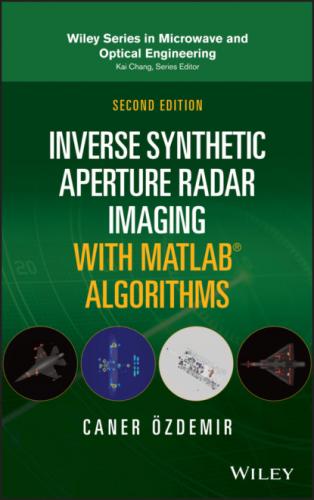(2.70)
On the left‐hand side of this equation, c terms are canceled, whereas Δt terms are canceled on the right‐hand side. Then, the pulse width after the reflection can be written in terms of the original pulse width as
(2.71)
The term (c − vr)/(c + vr) is known as the dilation factor in the radar community. Notice that when the target is stationary (vr = 0), then the pulse duration remains unchanged (τ' = τ) as expected.
Now, consider the situation in Figure 2.22c. As trailing edge of the second pulse is hitting the target, the target has traveled a distance of
within the time frame of dt. During this period, the leading edge of the first pulse has traveled a distance of
(2.73)
On the other hand, the leading edge of the second pulse has to travel a distance of (c/fPR − D) at the instant when it reaches the target. Therefore,
(2.74)
Solving for dt yields
Putting Eq. 2.75 into 2.72, one can get
(2.76)
The new PRF for the reflected pulse is
(2.77)
Substituting Eq. 2.75 to the above equation, one can get the relationship between the PRFs of incident and reflected waves as
(2.78)
If the center frequency of the incident and reflected waves are f0 and
(2.79)
To find the Doppler shift in the frequency, fD, we should subtract the center frequency of the incident wave from the center frequency of the reflected wave as
(2.80)
Since it is also obvious that the target velocity is very small compared to the speed of light (i.e. vr ≪ c), Eq. 2.81 simplifies as
where λ0 is the wavelength corresponding to the center frequency of f0. For the target that is moving away from the radar, the Doppler frequency shift has a negative sign as
(2.82)
Figure 2.23 Doppler shift is caused by the target's radial velocity, vr.
It is clear from these equations that Doppler frequency shift is directly proportional to the velocity of the target. If the velocity increases, the shift in the frequency increases as well. If the target is stationary with respect to radar (vr = 0), then the Doppler frequency shift is zero. The velocity vr in the above equation corresponds to the velocity along the RLOS direction. If the target is moving along another direction, vr refers to the velocity projected toward the direction of radar. If the target's velocity is v as illustrated in Figure 2.23, then the Doppler frequency shift in terms of the target's original velocity will be equal to
(2.83)
2.8 Matlab Codes
Below are the Matlab source codes that were used to generate all of the Matlab‐produced figures in this chapter. The codes are also provided in the CD that accompanies this book.
Matlab code 2.1 Matlab file “Figure2‐9.m”
%--------------------------------------------------------- % This code can be used to generate Figure 2.9 %--------------------------------------------------------- %---Figure 2.9a--------------------------------------------- clear close all fo=1e3; % set the frequency t=-4e-3:1e-7:4e-3; % choose time vector s=cos(2*pi*fo*t); % time domain CW signal plot(t*1e3,s,'k','LineWidth',2); grid minor set(gca,'FontName', 'Arial', 'FontSize',12,'FontWeight','Bold'); xlabel('\ittime, ms'); ylabel('\itamplitude, V'); axis([-4 4 -1.2 1.2]) %---Figure 2.9(b)------------------------------------------- N=length(t); df=1/(t(N)-t(1)); % Find frequency resolution f=-df*(N-1)/2:df:df*(N-1)/2; % set frequency vector figure; S=fft(s)/N; % frequency domain CW signal plot(f*1e-3,fftshift(abs(S)),'k','LineWidth',2); grid minor set(gca,'FontName', 'Arial', 'FontSize',12,'FontWeight','Bold'); xlabel('\itfrequency, KHz'); ylabel('\itamplitude, V'); axis([-.8e1 .8e1 0 .6])
Matlab code 2.2 Matlab file “Figure2 ‐ 11.m”
%-------------------------------------------------------- % This code can be used to generate Figure 2.11 %-------------------------------------------------------- clear close all fo=100; % set the base frequency t=0:1e-7:4e-3; % choose time vector k=3e6; % select chirp rate m=sin(2*pi*(fo+k*t/2).*t); % time domain FMCW signal plot(t*1e3,m,'k','LineWidth',2); grid minor set(gca,'FontName', 'Arial', 'FontSize',12,'FontWeight','Bold'); xlabel('\ittime, ms'); ylabel('\itamplitude, V'); axis([0 4 -1.1 1.1])
Matlab
